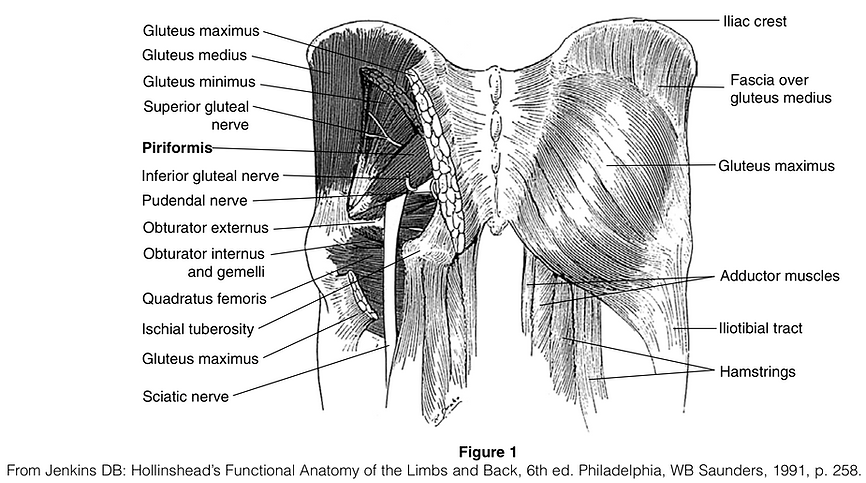Piriformis Syndrome
■ ■ ■ Description
Piriformis syndrome is a rare nerve condition in the hip, causing pain and occasionally loss of feeling in the back of the thigh, often to the bottom of the foot. It involves compression of the sciatic nerve at the hip by the piriformis muscle. The piriformis muscle rotates the hip, allowing the thigh, foot, and knee to point outward. The piriformis muscle travels from the pelvis to the outer hip. The sciatic nerve usually passes the hip between this muscle and other muscles of the hip. Occasionally (15% to 20% of the time) the nerve travels directly through the muscle, causing pressure on the nerve.
■ ■ ■ Common Signs and Symptoms
-
Tingling, numbness, or burning in the back of the thigh to the knee and occasionally the bottom of the foot
-
Occasionally, tenderness in the buttock
-
Pain and discomfort (burning, dull ache) in the hip or groin, mid-buttock area, or back of the thigh and sometimes to the
knee
-
Heaviness or fatigue of the leg
-
Pain that is worse with sports activities, such as running, jumping, long walks, and walking up stairs or hills, and is
often felt at night or with prolonged sitting
-
Pain that is lessened by laying flat on the back
■ ■ ■ Causes
Pressure on the sciatic nerve at the hip by anything that may cause the piriformis muscle to spasm and constrict the nerve can cause this syndrome. This includes strain from a sudden increase in the amount or intensity of activity or overuse of the lower extremity. It may also be due to compensation of other extremity injuries.
■ ■ ■ Risk Increases With
-
Sports involving running, jumping, or prolonged walking
-
Being born with the nerve traveling through the piriformis muscle
-
Poor physical conditioning (strength and flexibility)
■ ■ ■ Preventive Measures
-
Appropriately warm up and stretch before practice or competition.
-
Maintain appropriate conditioning:
-
Hip flexibility
-
Strength and endurance
-
Cardiovascular fitness
-
■ ■ ■ Expected Outcome
This condition is usually curable with appropriate treatment, or sometimes it heals spontaneously, within 2 to 6 weeks. Uncommonly, surgery is necessary.
■ ■ ■ Possible Complications
-
Permanent numbness in the affected knee, leg, and foot
-
Persistent pain in the knee, leg, and foot
-
Increasing weakness of the extremity
-
Disability and inability to compete
■ ■ ■ General Treatment Considerations
Initial treatment consists of rest from the offending activity and the use of medications to help reduce inflammation and pain. Stretching exercises of the muscles of the hip are useful. Referral to a physical therapist or an athletic trainer may be recommended for further treatment, including ultrasound and other modalities. Injections with cortisone, often with numb- ing medicine, in the area where the nerve is being pinched may help reduce the nerve inflammation and pinching. If this conservative treatment is not successful, surgery may be necessary to free the pinched nerve by cutting the muscle or tendon where the nerve is being pinched. Surgery is rarely necessary but does provide almost complete relief in most
patients who undergo this operation.
■ ■ ■ Medication
-
Nonsteroidal anti-inflammatory medications, such as aspirin and ibuprofen (do not take within 7 days before surgery), or other minor pain relievers, such as acetaminophen, are often recommended. Take these as directed by your physician. Contact your physician immediately if any bleeding, stomach upset, or signs of an allergic reaction occur.
-
Pain relievers may be prescribed as necessary by your physician, usually only after surgery. Use only as directed and only as much as you need.
-
Injections of corticosteroids may be given to reduce inflammation.
■ ■ ■ Heat and Cold
-
Cold is used to relieve pain and reduce inflammation for acute and chronic cases. Cold should be applied for 10 to 15 minutes every 2 to 3 hours for inflammation and pain and immediately after any activity that aggravates your symptoms. Use ice packs or an ice massage.
-
Heat may be used before performing stretching and strengthening activities prescribed by your physician, physical therapist, or athletic trainer. Use a heat pack or a warm soak.
■ ■ ■ Notify Our Office If
-
Symptoms get worse or do not improve in 2 weeks despite treatment
-
New, unexplained symptoms develop (drugs used in treatment may produce side effects)

View as PDF